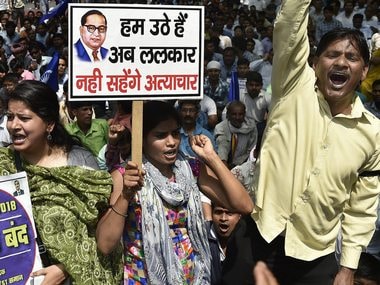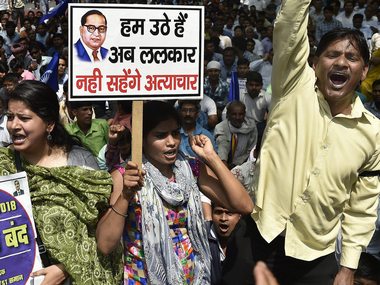Angry protests broke out across India on 2 April this year, against a Supreme Court judgment that was seen as protecting those who commit atrocities against Dalits. Crowds of protestors gathered in towns and cities of Gujarat, Rajasthan, Haryana, Punjab, Uttar Pradesh, Madhya Pradesh, Bihar, Odisha, Maharashtra and other places, protesting the apex court verdict, stopping rail and road traffic and confronting police forces. On 20 March, a two-judge bench of the Supreme Court diluted the provisions of the Scheduled Castes and the Scheduled Tribes (Prevention of Atrocities) Act, 1989, criticising the “abuse of law” that was taking place and saying it was becoming an “instrument of blackmail”. Further, the Narendra Modi government at the Centre was seen as dilly-dallying in its response to the court’s order. Dalit organisations across the country expressed their anger towards the government, and the Opposition quickly took up the issue, accusing the government of being anti-Dalit. Modi’s statement that his government is working for the Dalits wasn’t even heard by the Dalits. The growing discontentment among Dalits, and their increased assertiveness, is posing a major problem for Modi. And it’s not just from outside; there is trouble from within the party too, with BJP’s Dalit MPs openly voicing their dissent against the way in which the party has handled the issue. The importance of Dalit voters The Bharatiya Janata Party (BJP) relied heavily on Dalit votes for its electoral victory. India’s 200 million Dalits and 104 million indigenous people together form 25 percent of the country’s 1.2 billion population. Then there are at least 40 percent of Indians who belong to backward castes, taking the number of disadvantaged people close to 70 percent. [caption id=“attachment_4422705” align=“alignleft” width=“380”]  Members of the Dalit community protest against the government. PTI[/caption] In 2014, BJP had won 40 of them, according to the Centre for Study of Developing Societies. The year 2014 seemed to mark a big shift in the way Dalits voted. BJP gained nearly a quarter of Dalit votes for the first time. Compared to 2009, the BJP’s voteshare rose twice over. It was 10 percent better than its previous best performance, in 1998. And considering there are 84 parliamentary seats reserved for Dalits — constituencies dominated by the Dalit community — they played a big part in ensuring victory for the saffron party. Quoting data from National Election Studies (NES), post-poll surveys across the country conducted by Lokniti, a research program at the Delhi-based Centre for Study of Developing Societies (CSDS), suggest that Dalit voters have historically supported the Congress party. From 1996 till 2009, Congress had the support of at least a quarter of Dalit votes. The Bahujan Samaj Party (BSP) was a close second to the Congress in these elections. BJP accused of ignoring Dalits After 2014, however, BJP has been accused of constantly ignoring Dalit interests. Anti-Dalit violence, followed by a complete lack of remedial measures taken by the BJP, since 2015, have angered Dalit organisations. Incidents like the suicide of Rohith Vemula, the assault by cow vigilantes on Dalits in Una, attack on Dalits in Saharanpur in 2016, the violence during the Bhima Koregaon commemoration on 1 January this year, and finally the Supreme Court’s ruling diluting the SC/ST Act. There have been tension and violence at marriage processions, over Dalit youth sporting moustaches, riding horses, etc. Statues of BR Ambedkar have been defaced. Dalit organisations see these are forced caste conservatism fostered by the BJP. And although Modi has said nobody has showed more respect to Ambedkar than his government, this is not what the Dalit organisations wanted to hear. They took these as tokenistic appeals. BJP’s biggest achievement since 2014 is to form a government with a huge majority in Uttar Pradesh. A CSDS study said that the BJP had 12 percent of the Dalit vote in 2009, which doubled to 24 percent by 24 percent. This also meant Mayawati did not get a single seat. But then the political equation changed rapidly. The Samajwadi Party (SP) won Lok Sabha bypolls to Phulpur and Gorakhpur earlier this year. An informal alliance between the SP and BSP gave warning signs to the BJP. Bypolls to these constituencies were necessitated after Chief Minister Yogi Adityanath and his deputy Keshav Prasad Maurya vacated the Gorakhpur and Phulpur seats respectively, following their victories in the Assembly elections.
In just over a year since the Assembly election victory, the BJP’s well-crafted social engineering fell apart. The successful informal coalition between traditional rivals SP and BSP defeated the BJP in their traditional bastions, thereby also changing the political narrative of the state. The results were warning enough that Dalit voters may well go back to the BSP.
The Nitish Kumar formula In Bihar, Nitish Kumar’s social engineering formula seems to have worked, and the BJP is eyeing this as a possible solution to soothe Dalit anger against the saffron party. It is experimenting with this in Uttar Pradesh as well. Adityanath recently suggested that his government was also considering bringing in quota for the ‘Mahadalits’ (most backward sections) to ensure their upliftment. This, it is believed, will reduce the impact of the SP-BSP coalition and create a positive atmosphere for the government within the Mahadalit community. In fact, it was this social engineering formula started by Nitish Kumar in Bihar which contributed to the BJP’s defeat in the state in 2015. Much later, Nitish himself became part of the BJP-led coalition. And now, the BJP wants to adopt Nitish’s formula in Uttar Pradesh. The party claims this will bring development to the most backward castes among Dalits. But whether this ‘quota within quota’ formula reaps electoral benefits for the BJP remains to be seen. The party is not only promising sub-quotas for Most Backward Classes (MBC) in government jobs, educational institutions and Panchayats in Uttar Pradesh, it is also turning its special focus on “ati-Dalits” (extremely deprived) and exploring a sub-quota for them. Why in Uttar Pradesh? Most of the rebel Dalit ministers are from Uttar Pradesh. In the 2014 Lok Sabha elections, the BJP swept to power with absolute majority in several states. It won all of Rajasthan’s 25 seats and Gujarat’s 26. Uttar Pradesh, India’s largest state with 80 Lok Sabha seats, is particularly crucial. In 2014, BJP won 71 of these. It also won 40 out of 66 reserved seats, a win rate of 60 percent. This is the reason BJP is working hard to woo back the Dalit voters in Uttar Pradesh. BJP president Amit Shah took on the state as a test of his abilities. And his next litmus test will come in the form of a by-election to Kairana Lok Sabha constituency. Before the 28 May by-election, the party hopes to apply recruitment to jobs on the basis of the ‘Mahadalit-ati-backward Dalit’ formula. This, it is believed, will create a positive image about the government within the backward and Mahadalit communities. Furthermore, by reaching out to these communities, the party could also perform better in the next Lok Sabha polls. This could also be an example of how reservation can be used for the upliftment of poor and backward communities, thereby proving it is not anti-reservation. Although the BJP has tried many other ideas of wooing Dalit voters — like eating with them or staying with them — these steps were seen as political stunts by the party. The BJP now realises that the Dalit vote is fragmented, with smaller (non-national) parties taken together, accounting for the largest chunk. BJP also realises that the Dalit vote is fragmented, with smaller (non-national) parties together accounting for the largest chunk. In fact, even in 2014, the BJP’s gain in the Dalit voteshare came at the cost of the Congress and BSP, both of whom saw a significant decline in their support base among the Dalits. The share of smaller parties increased marginally compared to the 2009 elections. The calculations for 2019 presume the BJP won’t be able to repeat those numbers, certainly not when there’s no UPA-II that India wants to free itself from. The BJP will have all levels of anti-incumbency to overcome — at the level of MLAs and MPs, state government, and at the Centre. In the Lok Sabha, 131 MPs are from the SC and ST population. Of them, 67 are from the BJP. With general elections a year away, the manoeuvring for the Dalit vote is intensifying. There can be no doubt that whoever captures their vote will have a distinct advantage.


)
)
)
)
)
)
)
)
)



